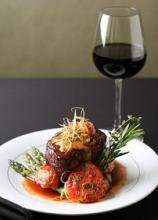There are a few hallmarks of culinary snobbery that are near universal. For instance, the baffling number of forks at a full table setting. While it actually is pretty absurd to dedicate an entire fork to, say, shrimp, other dining particulars aren't so baseless. One I'm particularly interested in defending is the careful pairing of drinks to certain kinds of food. By no means do I believe that these are hard and fast rules, but they are good suggestions that, at best, are intended to make the dining experience more pleasant.
Wine: White, Red or Blush?
We've all heard this one before. Red wine for red meat, white wine for fish and blush for poultry. But why? It's certainly not an arbitrary rule. Rather, it's about allowing the many subtle flavors inherent to wine to co-mingle with and ultimately amplify the flavors of the dish in question. Let's take a look at all three.
Red Wine
Reds have a tendency to be full-bodied with undertones of spice and warm floral elements. The red meat, red wine rule relates to the way the savory protein flavors in dishes like steak or lamb interact with the heavy, complex strands in a good red wine than it does with any particular chapter in a book of etiquette. Red meat isn't refreshing, it's powerful and complex. Likewise, the wine we drink with it ought to reflect that. It should also be noted that red wine pairs well with vegetarian dishes that favor pepper and balsalmic tones.
White Wine
On the other hand, white wine tends to carry sweet flavors, like fruit. This means that it pairs well with fish and seafood because fish and seafood itself has a compliment in sweet fruit and tart citrus. Most would rather see a mango salsa on a piece of fish than on a cut of venison, so one should seek out white wine for that fish as well. White wine is generally light and refreshing, so it naturally pairs better with crisp or gentle meals.
Blush Wine
Honestly, I'm on the fence about this one. This is my bias against blush wine speaking, but I often don't see the point in rose varieties when it seems they have all the weaknesses of both red and white but none of the strengths. There's no problem with leaning on a sweeter variety of red wine for gamey poultry like turkey or duck, then favoring dry white wine for lighter fare like chicken. Ultimately, it comes down to taste. Food should always be about what tastes the best to the individual, not what some dusty custom dictates.
Liquor
This is a somewhat more complex subject and also considerably more individualized. All the practice in the world won't make someone acquire a taste for scotch, but when one does there is nothing quite like a call brand on the rocks with an unconventional pairing. I find that scotch does particularly well with, of all things, East Asian cuisine like Chinese, Japanese and Thai. The smokey elements of scotch work well with spicy pepper flavors and the inherent heaviness of whiskey counterbalances the relative lightness of Asian food.
On the other end of the spectrum, citrus-loving spirits like vodka and gin go remarkably well with both general seafood and subtle regional fare like French and Spanish food.
I would always recommend supplementing any hard liquor with a glass of water during a meal. Liquor can compliment flavors, but it can't quench thirst. Responsibility and moderation are highly desired, even on a full stomach.
Beer
Especially given the wonderful (and relatively new) availability of hand-crafted microbrews in America and Canada, beer is back on the menu for proper pairing techniques. Beer does remarkably well with simple, greasy food like hamburgers and pizza because it has a high water content and favors a few strong flavors rather than any amount of complexity. Italian food, especially pizza and pasta, benefit from beers with a lot of hops because the floral tones mingle well with the herbs and spices of tomato sauce. Meanwhile, blunt and bitter ales carry the weight of simple pub fare with a surprising amount of grace, while heavy porter beers interact nicely with the acidic notes in fried fish and french fries.
Beverage pairing is a useful art, but it always comes down to individual preference. The "rules" are more like guidelines based on a few logical compliments. As in all cuisine, aim for whatever feels right, but don't discount the wisdom of the ages.
